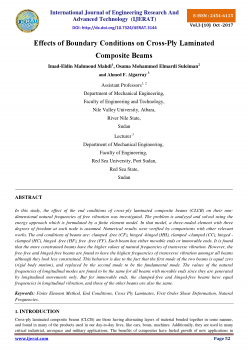
Effects of Boundary Conditions on Cross-Ply Laminated Composite Beams
In this study the effect of the end conditions of cross ply laminated composite beams CLCB on their nondimensional
natural frequencies of free vibration was investigated The problem is analyzed and solved using the
energy approach which is formulated by a finite element model In that model a three noded element with three
degrees of freedom at each node is assumed Numerical results were verified by comparisons with other relevant
works The end conditions of beams are clamped free CF hinged hinged HH clamped clamped CC hinged
clamped HC hinged free HF free free FF Each beam has either movable ends or immovable ends It is found
that the more constrained beams have the higher values of natural frequencies of transverse vibration However the
free free and hinged free beams are found to have the highest frequencies of transverse vibration amongst all beams
although they look less constrained This behavior is due to the fact that the first mode of the two beams is equal zero
rigid body motion and replaced by the second mode to be the fundamental mode The values of the natural
frequencies of longitudinal modes are found to be the same for all beams with movable ends since they are generated
by longitudinal movements only But for immovable ends the clamped free and hinged free beams have equal
frequencies in longitudinal vibration and those of the other beams are also the same



